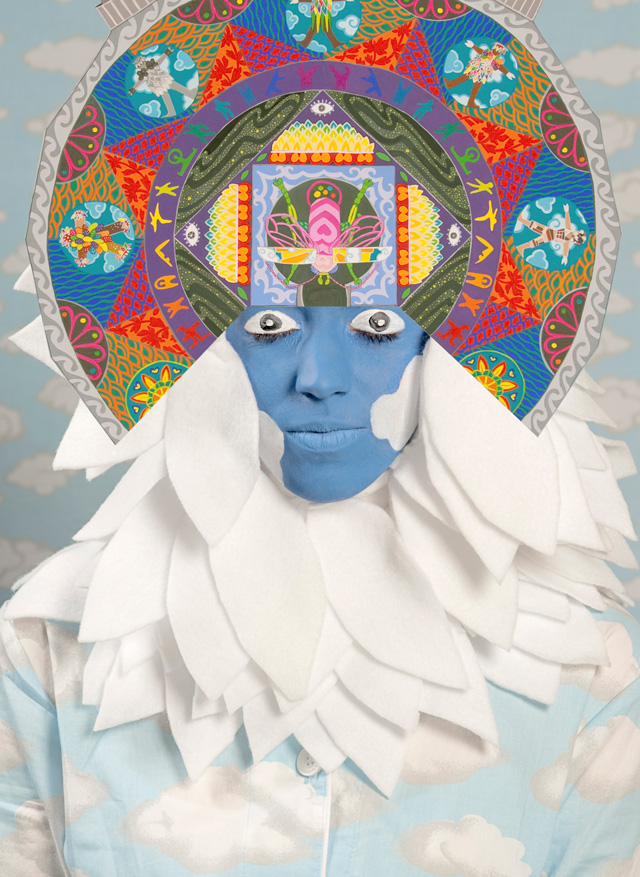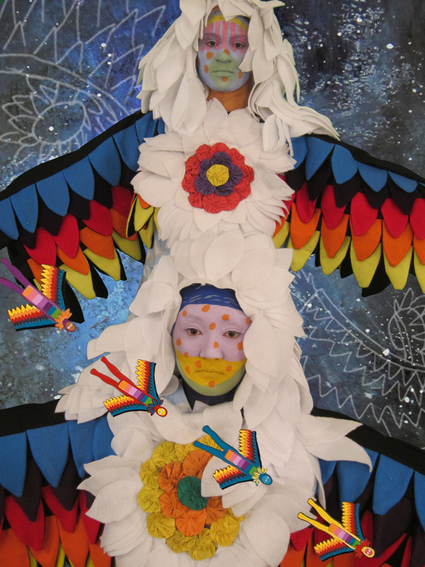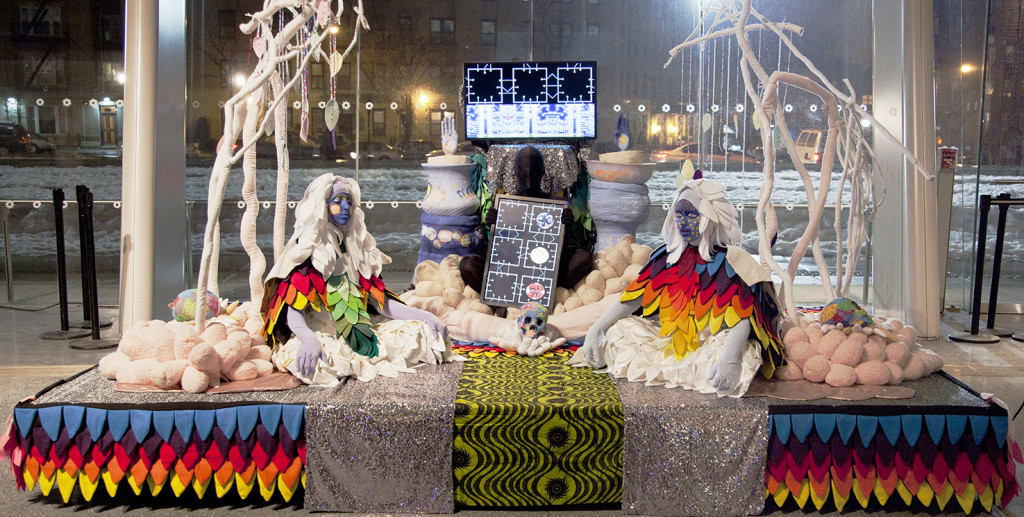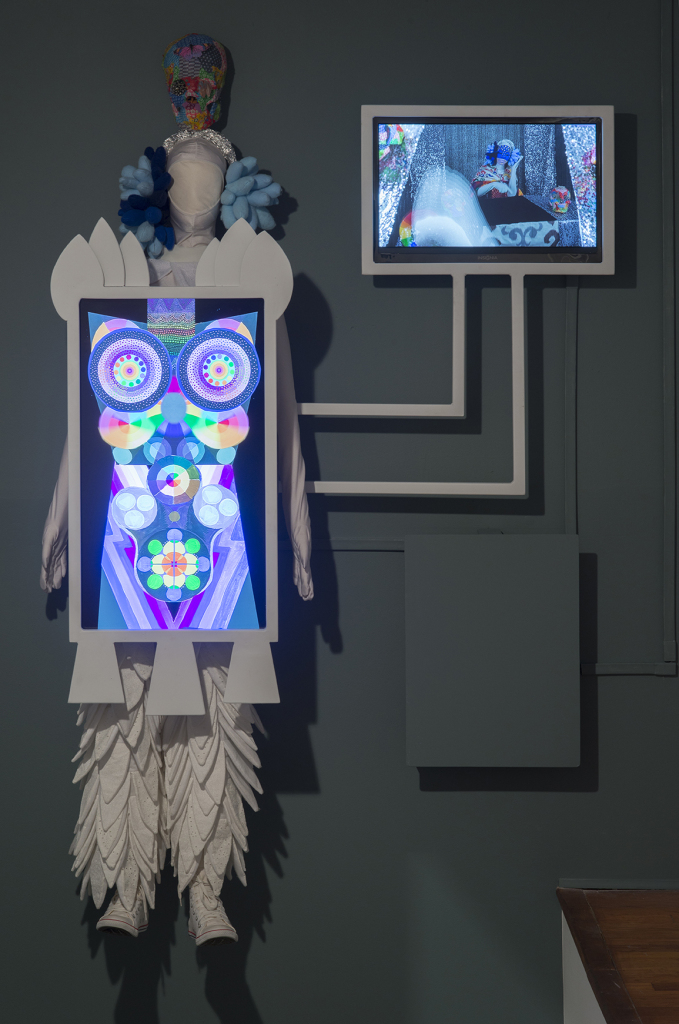
Gillian, digital photograph on watercolor paper, 40″ x 30″
2011
Saya Woolfalk’s exhibition “Chimera” was on view at Third Streaming through April 25, 2013.
nycARTscene’s Hannah Krafcik leads us in conversation with the artist:
HK: You present your artwork as fragments of a fantastical world beyond what we know. Our only point of access is through what you show us, and this is all birthed from a detailed narrative. Can you summarize the narrative through-line of your work?
SW: The video in my show at Third Streaming, “Tour of the Institute of Empathy,” tells the entire story of the Empathics: they develop second heads; have hallucinations of various forms of biological and cultural mixture; and activate what they see in their hallucinations through various social “formations.”
This narrative has emerged through process. As I collaborate across disciplines one project comes out of the last. I attempt to follow the stories that emerge and tease them out to their logical conclusions.
I have been working on No Place and the Empathics for 6 years. From 2006-2008, I worked with filmmaker and anthropologist Rachel Lears to document a fictional future utopian world called No Place. The people of No Place are part human and part plant and change gender and color and transform into the landscape when they die. They also transform recycled materials into usable technologies. We presented our collaboration as film called Ethnography of No Place.
In 2009, I started to think about how people in the present might actually become like the people of this fictional future, and I started working with dancers, biologists, and neuroscientists to explore this concept. In 2012, I presented the material at the Montclair Art Museum, and decided to use ethnographic museum techniques to tell the story as it had emerged.
 HK: The No Placeans and Empathics’ world is comprised of what many consider a “craft” aesthetic, but interspersed are other objects recognizable from theater and performance. Can you speak to the blending of materials in your work?
HK: The No Placeans and Empathics’ world is comprised of what many consider a “craft” aesthetic, but interspersed are other objects recognizable from theater and performance. Can you speak to the blending of materials in your work?
SW: I love the idea that ordinary materials can be transformed into magical things. Since early in my art education the transformation of domestic materials and objects was presented as a powerful method for making art. I studied feminist art at Brown and worked with Faith Wilding at the Art Institute of Chicago (one of the founding participants of Womanhouse). As a kid, I also learned to sew from my grandmother in Japan; and, before I had a studio, sewing was a way I could make work on a domestic scale. Slowly the small objects transformed into immersive environments. After spending time in Brazil studying Carnaval, I started to build entire performative fantastical worlds.

HK: How has your interest in anthropology paved the way for your trajectory in visual art? Does this have any bearing on the multi-media and performative nature of what you create?
SW: When I started working, I was looking for a way to describe alternative world systems through playful artmaking. By using the descriptive methods of anthropology—poking fun at them, while also thinking with them—I have been able to immerse myself in the logics of the places I construct. I am also surrounded by anthropology everyday. My husband is an anthropologist, and he is one of my inspirations.

HK: Because you take such an anthropological approach to discussing and presenting your work, people who visit your exhibitions have been know to wonder if what you are “studying” might actually be real. Do you think it is? Did you create these beings? Are they from the future, do they exist in an alternate reality, or do they come into being from your imagination?
SW: I love this question. I do think Empathics exist. They are people who struggle with intergroup contact and attempt to take disparate material and fuse it and make it make sense. In some way we are all Empathics. Being an Empathics is a kind of metaphor for the gradual transformation of US culture. In the US we experience conflict because of intergroup contact. We then incorporate parts of other cultures into our own. The nature of what it means to be United Statesian is constantly changing because of these contact points and our gradual transformation.

HK: Though you are based in New York City, you frequently show work outside of New York in the North East. Does your work and its intersection with nature draw you away from urban environments? What brings you back to New York for your latest exhibition, Chimera?
SW: As I enter into my next project, “Land of the Pleasure Machines”—which is about biological and the technological mixture—movement between the urban and natural environments will emerge as an important element of my work. We have a little place we like to go in the woods of upstate NY where I can think and read and take walks with my husband and our daughter. The impact of these real experiences can be felt, and that’s what I love about Yona’s space [Third Streaming]. It is a wonderful urban place where many kinds of people come in contact with each other so that art and life can happen. It is a place where art is living and breathing and all sorts of fantastical things can happen.
Third Streaming: 10 Greene Street, NY, NY thirdstreaming.com
Saya Woolfalk: www.sayawoolfalk.com

No comments yet.